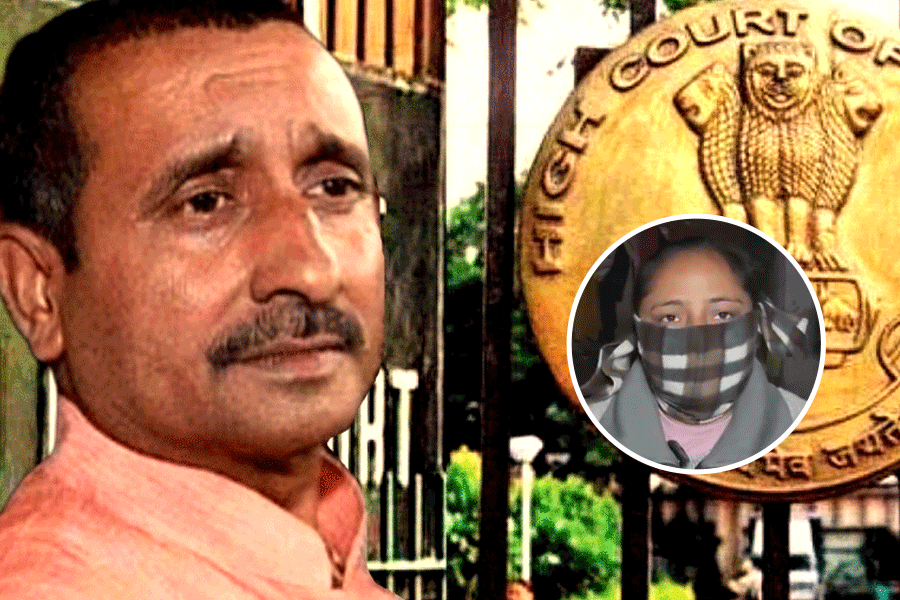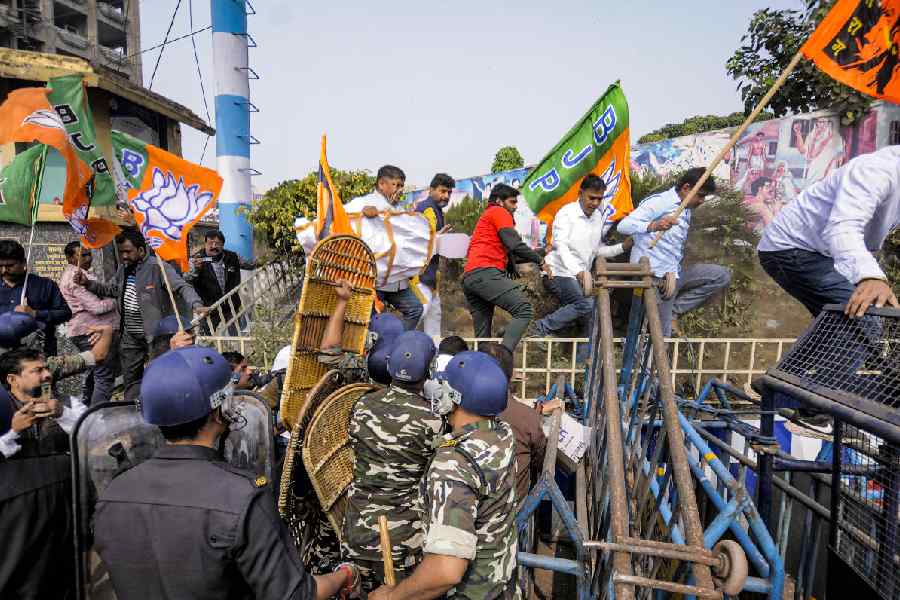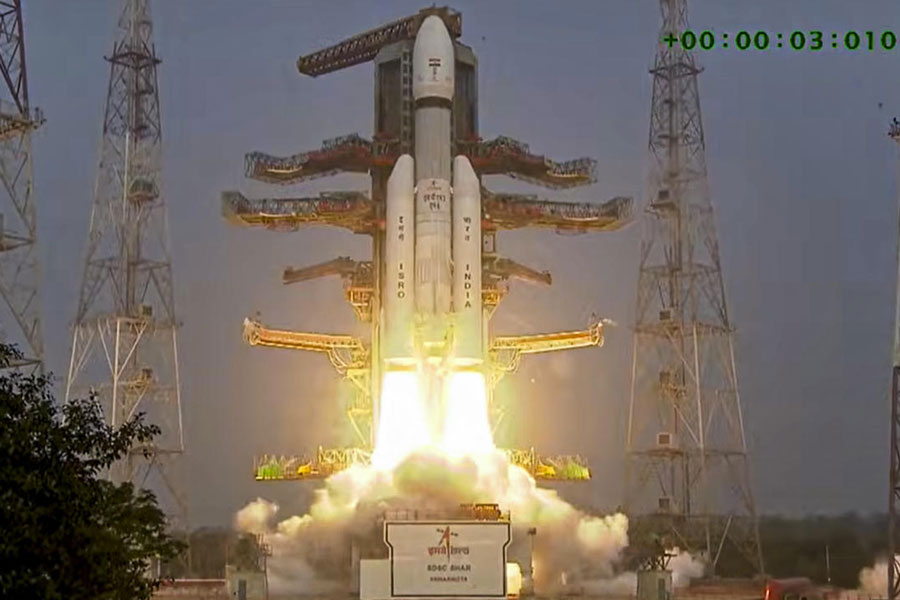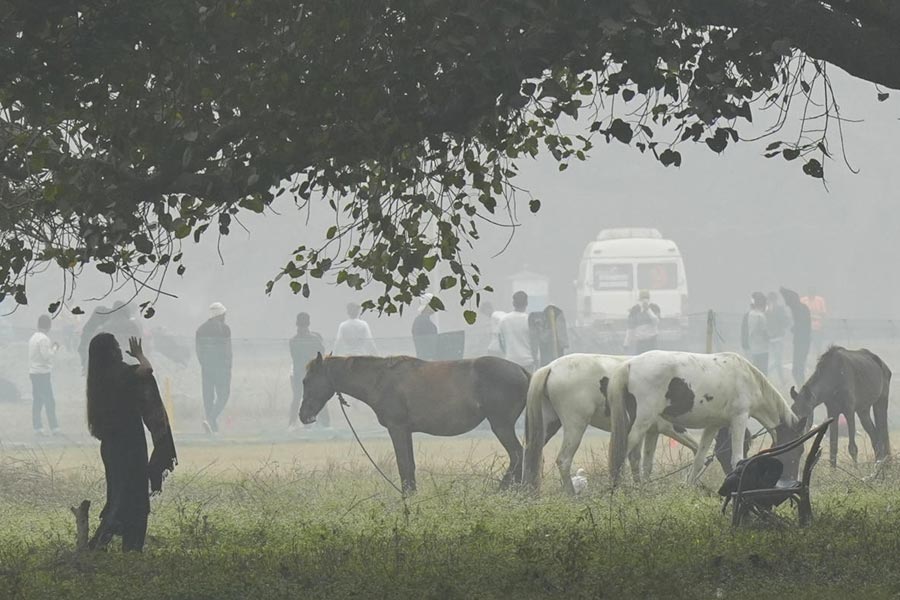 |
| High and dry: Jawans undergo pre-induction training at the base camp in the Siachen sector (top). Map marking the disputed area around the glacier. Graphic by Raj |
 |
 |
For a land named after the mountain rose, Siachen is something of a misnomer. For life is anything but rosy in the world’s highest battlefield — where gunfire is exchanged at upto 20,000 feet above sea level. But the dispute has been described as one of the most futile and wasteful conflicts in the world, for nine out of 10 deaths here are due to climate.
Now, for the first time in six years, the Siachen dispute will figure in talks between the defence secretaries of India and Pakistan in New Delhi this week. This will be the eighth round of discussions, the last being in 1998.
Twice, the two sides came close to settling the dispute. But as a former commanding general of the Siachen and Kargil sectors, Lt General (Retd) V.R. Raghavan writes in Siachen —Conflict Without End, the two sides have “found the political cost of ending the conflict more daunting than the prospect of living with it”.
The solutions proposed include demilitarisation of the glacier and of creating a “Zone of Disengagement”. However, mutual lack of trust has prevented a resolution. It is doubtful whether the talks would break new ground.
Brand Siachen
Siachen evokes strong passions in both India and Pakistan. It was for the brand rub-off of Siachen that former defence minister George Fernandes visited the Glacier so often.
Pakistan’s President General Pervez Musharraf’s “Siachen consciousness” is also very high. In September 1987, as brigade commander of the Special Services Group, he was responsible for leading an attack on an Indian position at Bilafond La, one of the two main passes on the Saltoro ridge, to the Siachen Glacier from Pak occupied Kashmir (PoK). His forces had to retreat. Having also served as Pakistan’s Force Commander, Northern Areas, he knows the Siachen dispute intimately.
Although the boundary dispute between India and Pakistan in this region is referred to as the Siachen dispute, the Siachen Glacier is in fact in India’s control. There is no battle raging on the Glacier itself. Indian soldiers sit on the Saltoro ridge to the west of Siachen. Between the Pakistani forces and the Glacier, there are high mountain peaks controlled by India. The Siachen Glacier flows in the valley formed by the Saltoro ridge to its west and the Eastern Karakorams. It is about 72 km long from its highest point at Indira Col to its snout.
The Iceland
Militarily, the Siachen Glacier can be divided into three parts. The Northern Glacier is the most formidable, containing the highest peaks. The Central part is where the Glacier is broadest — up to 20 km wide and this is where India has its Kumar Post from where expeditions are launched to the various Saltoro peaks. The Southern Glacier is just four to five km wide. Helicopters maintain the Northern and Central Glacier while ponies and porters supply the Southern Glacier.
Arms and the Men
The Indian Army has taken 105 mm field guns to the Glacier to support the peaks. They are deployed at the lower end of the Northern Glacier and in the Southern Glacier. The Base Camp has 130 mm and the Bofors 155 mm guns.
The difficulty in using field guns on the Glacier arises from the shifting ice — moving by about two inches a day in winters and 10 to 20 feet a day in summer. Registering a target and using the calculations to shoot after even a couple of days will not guarantee a hit because of shifting gun positions.
At any point of time three battalions are deployed, three are in training and three awaiting orders. The soldiers manning the observation posts on the Saltoro and the camps have to be relieved every 30 days to three months.
The Costs of War
The estimates of the costs of hostilities on Siachen vary. “No one has an accurate assessment, but everyone has a figure to quote and a point to make,” says General Raghavan. Without endorsing any estimate, he quotes cost figures ranging from US $ 1.2 million per day for both India and Pakistan; $1.94 million a day for India alone; and Rs 2.5 crore to Rs 6.5 crore for India alone to $18.5 million a day for Pakistan and 30 times that for India. Pakistan’s former foreign secretary Shaharyar Khan once said that the cost of a ‘rote’ for a Pakistani soldier posted in that region is more than Rs 450. Fernandes told Parliament that Siachen costs the exchequer Rs 3 crore per day.
The Starting Point
The Siachen dispute originated because the boundary in Jammu and Kashmir after the Karachi Agreement of 1949 was not fully demarcated. A cease-fire line (CFL) on the map ended at a grid point with co-ordinates NJ9842 on the Saltoro ridge.
This was near the northern-most point where troops were deployed when the fighting ended in 1948. Although the CFL subsequently changed into the Line of Control (LoC) after the Shimla Agreement of 1972, its end points remained the same.
The descriptive explanation of the boundary beyond NJ9842 — “thence North to the Glaciers” — has created some confusion. India believes that this means that the boundary would go north through the nearest watershed, the Saltoro ridge. Pakistan draws a straight line from NJ9842 going north-east to the Karakoram pass. The former interpretation gives the control of the Glacier to India, the latter, to Pakistan.
The Conflict
In 1978, the Indian army became aware of maps showing the LoC as a straight line extended from NJ9842 to the Karakoram pass appearing in publications abroad. The same year an Indian Army mountaineering expedition led by Colonel . Kumar brought back evidence of foreign mountaineering expeditions being launched into the Siachen area from PoK. Both sides were convinced that the other was trying to establish a military presence in the area. It was then that India realised that Pakistan was behind the extension of NJ9842 to the Karakoram pass, claiming the Siachen glacier.
India Steps In
India objected to this “cartographic aggression”. The choice before the Indian Army was to either turn a blind eye or or pre-empt Pakistan. In late 1983, India learnt that Pakistan was purchasing high altitude gear and its troops were planning to occupy the passes leading to the Siachen Glacier.
Two months before the mountaineering season was to begin in April 1984, India airlifted two platoons of Kumaon Regiment and placed them on the two key passes of Bilafond La and Sia La on the Saltoro ridge.
Enter the Dragon
Both India and Pakistan see geo-political compulsions in fighting for Siachen. In 1963, Pakistan ceded 4,500 sq km of Kashmir, the Shaksgam Valley to the west of the Karakorams, to China because it wanted a border with China.
India did not recognise this settlement. However, New Delhi came to know of the Chinese activities in the area only a decade after China had built the Aksai Chin highway passing through it. The belated Indian presence on the Saltoro ridge abutting the Shaksgam Valley seeks to question the Sino-Pakistan ‘border settlement’.
Nothing to Fight For
Initially the Siachen conflict was also justified in terms of countering a threat to Ladakh from Pakistani forces coming down the Nubra Valley via Siachen. This is now considered logistically unviable. There are many, however, who argue that the Glacier has no strategic significance and its militarisation is the result of competing and irrational nationalism. That Siachen rankles in the Pakistani mind is evident from the fact that the Kargil misadventure, some in Pakistan claim, was aimed at undoing the Indian takeover of Siachen. One of its objectives was to snatch Siachen from India by cutting off the Srinagar-Leh route.
India Proposes
India and Pakistan have held seven rounds of talks on Siachen. They apparently came close to resolving the dispute in 1989 and again in 1992. These attempts were unsuccessful because of two reasons. Pakistan wants India to withdraw to pre-Shimla positions by vacating the Saltoro ridge but wants to retain its own military positions claiming that they are pre-1971 ones. Second, to keep up the myth of engaging India on the Siachen Glacier, it refuses to exchange maps marking the present ground positions. These would show that Pakistan is nowhere near the Siachen Glacier and that its posts on the Saltoro are at much lower heights (9,000 to 15,000 feet) than Indian ones.
Was there really a settlement in the offing in 1989? American scholar Robert Wirsig has claimed that India made six proposals to Pakistan in 1989: cessation of cartographic aggression by Pakistan (extending the LoC from NJ 9842 north-east to the Karakoram pass); establishing a demilitarised zone at Siachen; exchange of maps to show present positions; delimitation of the border beyond NJ9842 towards the China border based on ground realities; formulation of ground rules for future military stand-off — a measure of last resort; and redeployment of Indian and Pakistani forces to mutually agreed positions.
Pakistan Deposes
Pakistan apparently countered this with two alternative proposals: deployment of Indian and Pak forces to agreed positions held at the time of 1971 cease-fire (pre-Shimla positions); and only then, the delimitation of an extension of the LoC beyond NJ9842. There were differences over which should come first — delimitation or redeployment. Redeployment was seen as entirely an Indian withdrawal with Pakistan staying put. India was unwilling to accept only an Indian pullout.
Momentary Hope
In the sixth round of talks in 1992 India claimed that there was an understanding on the redeployment of Indian and Pakistani troops and on creating a “Zone of Disengagement” on either side of the Saltoro ridgeline. But Pakistan was again unwilling to mark its current deployment on a map, indicating the ground reality before disengagement. The hopes of Indian officials for a settlement were dashed when they approached the political leadership. The Zone of Disengagement Plan did not find political acceptance with Narasimha Rao’s minority government.
Changes in the Offing
In the round of talks in November 1998, India referred only to the Saltoro range with no mention of the Siachen Glacier. The proposal for a Zone of Disengagement was also dropped.
The 1998 proposals instead suggested a comprehensive ceasefire along the Saltoro region based on a freeze on present ground positions; discussions of the modalities of ceasefire in a time-frame; bilateral mechanisms for the cease-fire; and authenticating the existing position on the Saltoro range beyond NJ9842. Pakistan rejected the proposals. The Indian position had hardened in the face of Pakistani obduracy.
The army has the dominant say in the Siachen dispute. Its position is that there should be no asymmetrical redeployment of troops. To climb up the Saltoro peaks the Pakistani army does not have to traverse a glacier. If there is a pullback by the Indian Army to say, Leh or Turtuk but the Pakistanis stay in Skardu; they can occupy the key positions on the Saltoro ridge in 10 days’ time. It would take India nearly four months to do that.
There is little to indicate there is a light at the end of the tunnel. Many believe that the political leaderships both in Pakistan and in India are far too weak today to sell a Siachen solution to their people.










